Unit 5 Accounting Principles PDF
22 Pages4046 Words40 Views
Added on 2022-01-15
Unit 5 Accounting Principles PDF
Added on 2022-01-15
ShareRelated Documents
RECORDING AND FEEDING BACK ON LEARNER ACHIEVEMENT
Course / Award Pearson BTEC HND Level 5 in Business
Management
Unit 5 Accounting Principles
Student Name Nguyen Huu BaoTran_20BM40211
Assessment criteria that
have been achieved
Assessment Criteria that
are still to be achieved
Assessor’s feedback (specific to assessment criteria)
Student Name/Signature Rework Due
Date
Assessor Name /
Signature Date
IV Name / Signature Date
Assessor’s feedback on the rework:
Student Name/Signature Date
Assessor Name /
Signature Date
IV Name / Signature Date
Course / Award Pearson BTEC HND Level 5 in Business
Management
Unit 5 Accounting Principles
Student Name Nguyen Huu BaoTran_20BM40211
Assessment criteria that
have been achieved
Assessment Criteria that
are still to be achieved
Assessor’s feedback (specific to assessment criteria)
Student Name/Signature Rework Due
Date
Assessor Name /
Signature Date
IV Name / Signature Date
Assessor’s feedback on the rework:
Student Name/Signature Date
Assessor Name /
Signature Date
IV Name / Signature Date
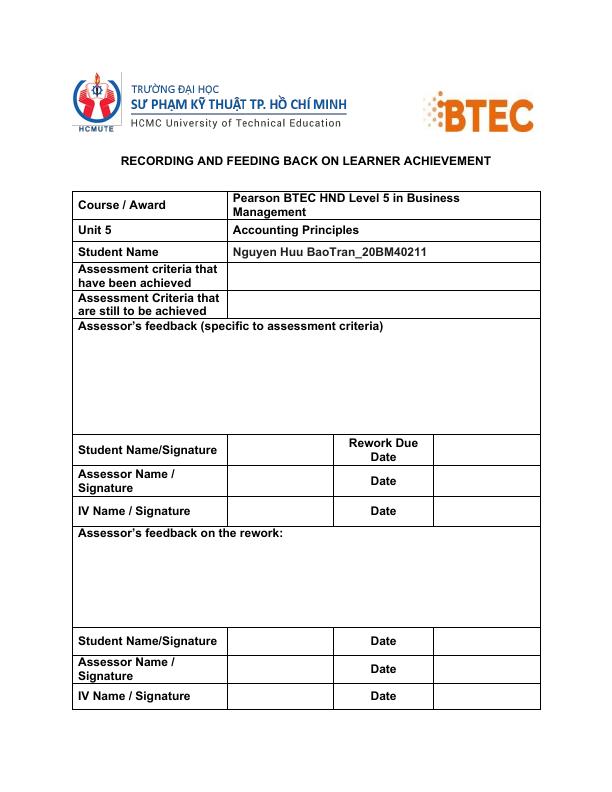
Assignment Brief
Student Name/ID Number Nguyen Huu BaoTran_20BM40211
Unit Number and Title Unit 5: Accounting Principles
Academic Year 2021-2022
Unit Tutor Sumit Dhull
Assignment Title 1/2: Accounting in Context and Budgetary Control
Issue Date 03 December 2021
Submission Date 03 January 2022
Internal Verifier Dang Quang Vang
Date of IV 02 January 2022
Student declaration
I certify that the work submitted for this assignment is my own. I have clearly referenced any
sources used in the work. I understand that false declaration is a form of malpractice.
Student signature: Nguyễn Hữu Bảo Trân Date: 02th January, 2022
TABLE OF CONTENTS
2
Student Name/ID Number Nguyen Huu BaoTran_20BM40211
Unit Number and Title Unit 5: Accounting Principles
Academic Year 2021-2022
Unit Tutor Sumit Dhull
Assignment Title 1/2: Accounting in Context and Budgetary Control
Issue Date 03 December 2021
Submission Date 03 January 2022
Internal Verifier Dang Quang Vang
Date of IV 02 January 2022
Student declaration
I certify that the work submitted for this assignment is my own. I have clearly referenced any
sources used in the work. I understand that false declaration is a form of malpractice.
Student signature: Nguyễn Hữu Bảo Trân Date: 02th January, 2022
TABLE OF CONTENTS
2
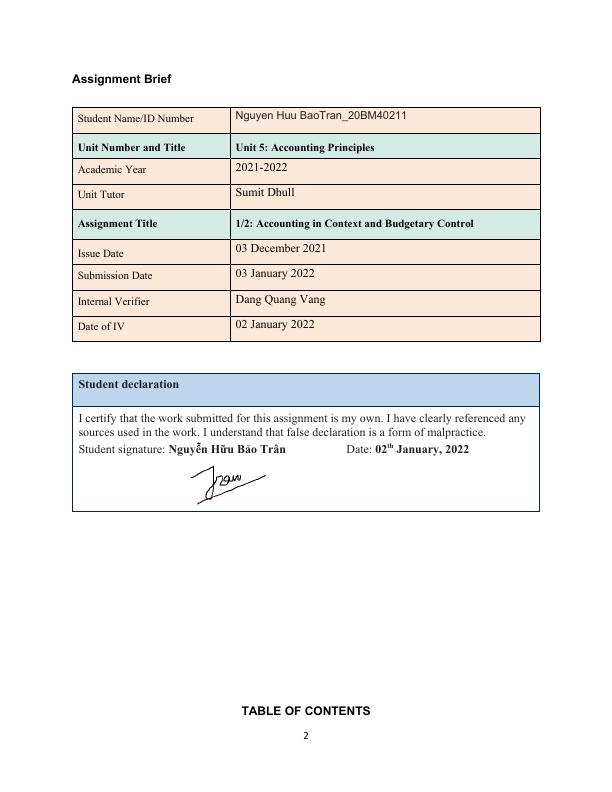
I/ INTRODUCTION..........................................................................................................4
II/ EXAMINE THE CONTEXT AND PURPOSE OF ACCOUNTING..............................5
A. The purpose of the accounting function.............................................................5
1. The accounting function.......................................................................................5
2. Difference between management accounting and finance accounting...............5
3. Types of Various users for private university.......................................................5
B. The accounting function within the organization in the context of regulatory
and ethical constraints..........................................................................................5
1. The structure of the cost allocation method.........................................................5
2. Calculation formula of cost allocation method......................................................6
3. Inventory management system............................................................................7
III/ BASIC FINANCIAL STATEMENTS FOR UNINCORPORATED AND SMALL
BUSINESS ORGANIZATIONS IN ACCORDANCE WITH ACCOUNTING PRINCIPLES,
CONVENTIONS, AND STANDARDS.............................................................................9
A. Accounting principles, conventions, and standards........................................9
1. Source documents................................................................................................9
2. Journals................................................................................................................10
3. Ledger (‘T’ account) .............................................................................................11
4. Trial Balance.........................................................................................................11
B. Financial statement................................................................................................12
1. Journals................................................................................................................12
2. Ledger (‘T’ account) .............................................................................................14
3. Trial Balance.........................................................................................................17
IV/ CONCLUSION...........................................................................................................18
V/ APPENDIX..................................................................................................................19
1. The accounting function.........................................................................................19
2. Difference between management accounting and finance accounting.................19
3. Types of Various users for private university........................................................21
VI/ REFERENCE.............................................................................................................22
I. INTRODUCTION
3
II/ EXAMINE THE CONTEXT AND PURPOSE OF ACCOUNTING..............................5
A. The purpose of the accounting function.............................................................5
1. The accounting function.......................................................................................5
2. Difference between management accounting and finance accounting...............5
3. Types of Various users for private university.......................................................5
B. The accounting function within the organization in the context of regulatory
and ethical constraints..........................................................................................5
1. The structure of the cost allocation method.........................................................5
2. Calculation formula of cost allocation method......................................................6
3. Inventory management system............................................................................7
III/ BASIC FINANCIAL STATEMENTS FOR UNINCORPORATED AND SMALL
BUSINESS ORGANIZATIONS IN ACCORDANCE WITH ACCOUNTING PRINCIPLES,
CONVENTIONS, AND STANDARDS.............................................................................9
A. Accounting principles, conventions, and standards........................................9
1. Source documents................................................................................................9
2. Journals................................................................................................................10
3. Ledger (‘T’ account) .............................................................................................11
4. Trial Balance.........................................................................................................11
B. Financial statement................................................................................................12
1. Journals................................................................................................................12
2. Ledger (‘T’ account) .............................................................................................14
3. Trial Balance.........................................................................................................17
IV/ CONCLUSION...........................................................................................................18
V/ APPENDIX..................................................................................................................19
1. The accounting function.........................................................................................19
2. Difference between management accounting and finance accounting.................19
3. Types of Various users for private university........................................................21
VI/ REFERENCE.............................................................................................................22
I. INTRODUCTION
3
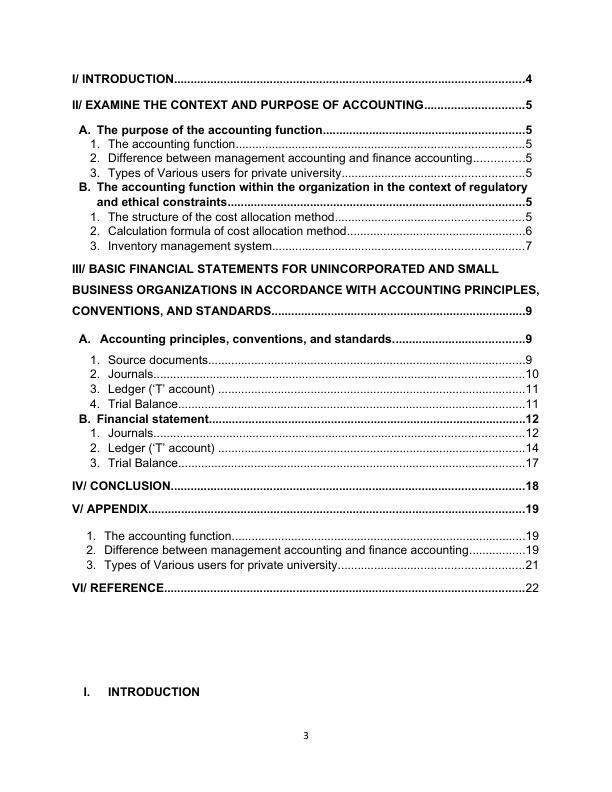
In the field of finance, accountants can understand and apply concepts and methods of
financial analysis accurately. The problems raised are scientifically arranged with
detailed solutions.
In this report, I will talk about the context, purpose of the accounting function in an
organization, Types of accounting and difference between management accounting and
financial accounting, Different types of users for private universities. The accounting
function within the organization in the context of regulatory and ethical constraints
includes the structure of the cost allocation method, the Calculation formula of the cost
allocation method, and the Inventory management system.
Next, I will evaluate the accounting function in the organization in the context of
regulatory and ethical constraints including what are the methods of cost allocation?
Explain these two methods in detail with their structure to calculate profit then calculate
and use a table to show the calculation. Moreover, I will explain JIT & JIC, order cost,
implementation cost, EOQ (with graph) and then I will calculate for JIT and JIC.
Finally prepare the basic financial statements for small business and unincorporated
organizations in accordance with accounting principles, conventions and standards by
preparing the financial statements from a certain trial balance for sole traders,
partnerships, and nonprofits, to meet accounting principles, conventions, and standards.
Next, I will explain the accounting cycle in great detail. About rules for the journal, steps
for the journal, 'T' Account, steps like prepare format, transfer log and find balance, trial
balance, and trial balance rule and then is to show the calculations on the following with
explanations.
II. EXAMINE THE CONTEXT AND PURPOSE OF ACCOUNTING
A. The purpose of the accounting function
4
financial analysis accurately. The problems raised are scientifically arranged with
detailed solutions.
In this report, I will talk about the context, purpose of the accounting function in an
organization, Types of accounting and difference between management accounting and
financial accounting, Different types of users for private universities. The accounting
function within the organization in the context of regulatory and ethical constraints
includes the structure of the cost allocation method, the Calculation formula of the cost
allocation method, and the Inventory management system.
Next, I will evaluate the accounting function in the organization in the context of
regulatory and ethical constraints including what are the methods of cost allocation?
Explain these two methods in detail with their structure to calculate profit then calculate
and use a table to show the calculation. Moreover, I will explain JIT & JIC, order cost,
implementation cost, EOQ (with graph) and then I will calculate for JIT and JIC.
Finally prepare the basic financial statements for small business and unincorporated
organizations in accordance with accounting principles, conventions and standards by
preparing the financial statements from a certain trial balance for sole traders,
partnerships, and nonprofits, to meet accounting principles, conventions, and standards.
Next, I will explain the accounting cycle in great detail. About rules for the journal, steps
for the journal, 'T' Account, steps like prepare format, transfer log and find balance, trial
balance, and trial balance rule and then is to show the calculations on the following with
explanations.
II. EXAMINE THE CONTEXT AND PURPOSE OF ACCOUNTING
A. The purpose of the accounting function
4
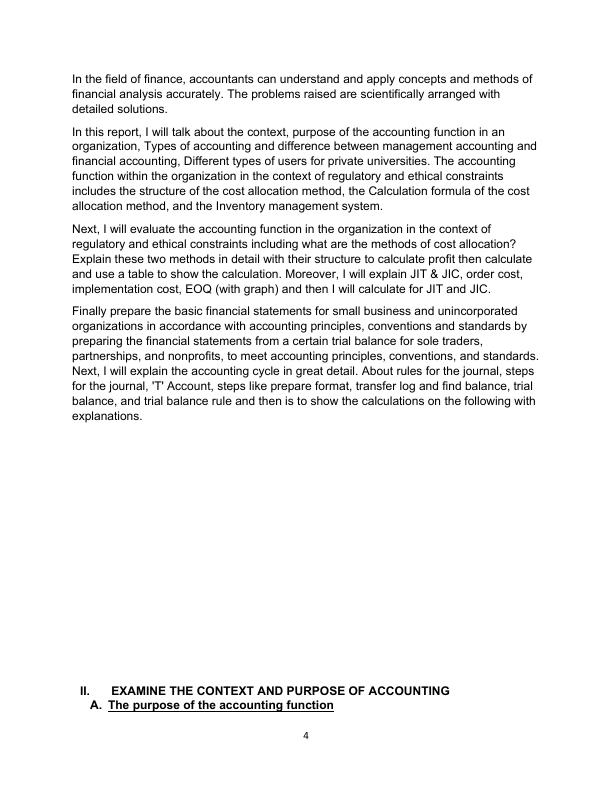
See appendix page 18
B. The accounting function within the organization in the context of regulatory
and ethical constraints
1. The structure of the cost allocation method
2. Calculation formula of cost allocation method
5
Cost allocation
method
By operations
Manufacturing cost
Direct material Raw material
Direct labor Working on
machine
Overhead
Indirect material
Indirect labor
Indirect expense
Non-Manufacturing
cost
Marketing
Advertising
Transportation
Administration Salary, insurance,
rent, depriciation
By behavior
Variable cost
Manufacturing
variable cost
Direct material,
labor
Non-Manufacturing
variable cost
Packaging,
advertising, labeling
transportation
Fixed cost
Manufacturing
fixed cost Rent
Non-Manufacturing
fixed cost Administration cost
B. The accounting function within the organization in the context of regulatory
and ethical constraints
1. The structure of the cost allocation method
2. Calculation formula of cost allocation method
5
Cost allocation
method
By operations
Manufacturing cost
Direct material Raw material
Direct labor Working on
machine
Overhead
Indirect material
Indirect labor
Indirect expense
Non-Manufacturing
cost
Marketing
Advertising
Transportation
Administration Salary, insurance,
rent, depriciation
By behavior
Variable cost
Manufacturing
variable cost
Direct material,
labor
Non-Manufacturing
variable cost
Packaging,
advertising, labeling
transportation
Fixed cost
Manufacturing
fixed cost Rent
Non-Manufacturing
fixed cost Administration cost
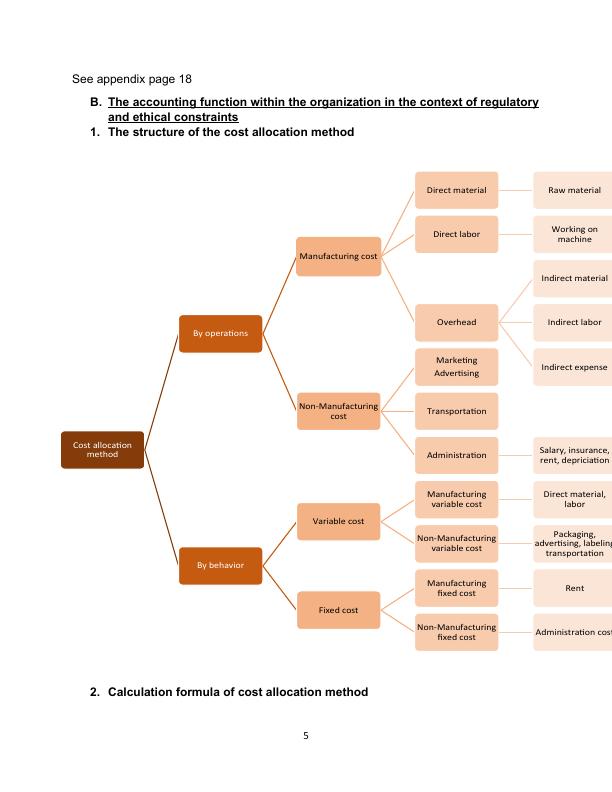
Absorption costing
• Sales - Cost Of Goods Sold= Gross Profit - Non-manufacturing Cost = Net Profit
Or Loss
• Opening Inventory (Unit) +Production (Unit) - Closing Inventory (Unit) = COGS In
Unit x Manufacturing Cost per Unit (Direct & Indirect) = COGS In $
January February March
Sales(1) 16500 22000 22000
Cost Of Goods Sold(2) 12000 16000 16000
Gross Profit 4500 6000 6000
Non-manufacturing
Cost
0 0 0
Net Profit 4500 6000 6000
(1) Sales= sales unit x selling price per unit = 1,500 x £11 = 16500
(2) COGS= units sold x manufacturing cost per unit (variable cost per unit + fixed cost
per unit) = 1,500 x 8 = 12000
Marginal costing
• Sales - Variable Manufacturing Cost - Variable Non-manufacturing Cost =
Contribution Margin - Fix Manufacturing Cost - Fix Non-manufacturing = Net
Profit Or Loss
January February March
Sales (1) 16500 22000 22000
Cost Of Goods Sold
(2)
7500 10000 10000
Variable non-
manufacturing cost
0 0 0
Contribution margin
(3)
9000 12000 12000
Fix manufacturing
cost (4)
9000 9000 9000
Fix non-
manufacturing cost
0 0 0
Net profit or loss 0 3000 3000
(1) Sales= sales unit x selling price per unit = 1,500 x £11 = 16500
(2) COGS= sales unit x variable cost per unit = 1,500 x £5 = 7500
(3) Contribution margin= Sales – COGS= 16500 – 7500= 9000
6
• Sales - Cost Of Goods Sold= Gross Profit - Non-manufacturing Cost = Net Profit
Or Loss
• Opening Inventory (Unit) +Production (Unit) - Closing Inventory (Unit) = COGS In
Unit x Manufacturing Cost per Unit (Direct & Indirect) = COGS In $
January February March
Sales(1) 16500 22000 22000
Cost Of Goods Sold(2) 12000 16000 16000
Gross Profit 4500 6000 6000
Non-manufacturing
Cost
0 0 0
Net Profit 4500 6000 6000
(1) Sales= sales unit x selling price per unit = 1,500 x £11 = 16500
(2) COGS= units sold x manufacturing cost per unit (variable cost per unit + fixed cost
per unit) = 1,500 x 8 = 12000
Marginal costing
• Sales - Variable Manufacturing Cost - Variable Non-manufacturing Cost =
Contribution Margin - Fix Manufacturing Cost - Fix Non-manufacturing = Net
Profit Or Loss
January February March
Sales (1) 16500 22000 22000
Cost Of Goods Sold
(2)
7500 10000 10000
Variable non-
manufacturing cost
0 0 0
Contribution margin
(3)
9000 12000 12000
Fix manufacturing
cost (4)
9000 9000 9000
Fix non-
manufacturing cost
0 0 0
Net profit or loss 0 3000 3000
(1) Sales= sales unit x selling price per unit = 1,500 x £11 = 16500
(2) COGS= sales unit x variable cost per unit = 1,500 x £5 = 7500
(3) Contribution margin= Sales – COGS= 16500 – 7500= 9000
6
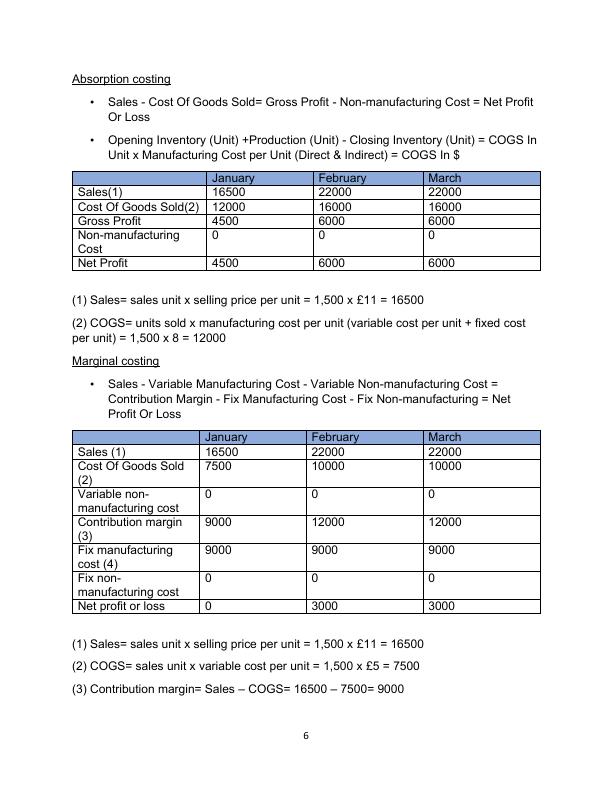
End of preview
Want to access all the pages? Upload your documents or become a member.
Related Documents
Assessment Processes & Planning for Pearson BTEC HND Level 5 Business Management Unit 2lg...
|16
|4233
|459
Unit 1 Business and Business Environment PDFlg...
|19
|5169
|37
Unit 10 : financial accounting assignmentlg...
|33
|6609
|679
Assignment - Recording Financial Transactionslg...
|30
|8780
|428
Financial Accounting Final Exam - Deskliblg...
|20
|3931
|220
Financial Accounting Assessment 2lg...
|23
|4971
|466
